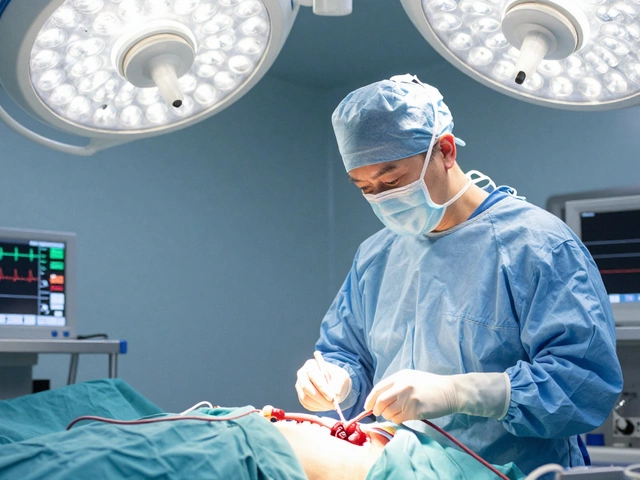Embarking on the path to recovery after knee replacement surgery requires patience and planning, especially when it comes to returning to work. The recovery journey is as unique as the individuals who traverse it, marked by milestones that guide you back to daily life and professional responsibilities. How soon you should resume work is a common concern, and the answer is influenced by several factors including the nature of your job and your healing pace.
While some may find themselves back at their desks within a few weeks, others, particularly those with physically demanding roles, might face a longer wait. It's crucial to understand this recovery timeline and the elements at play. Armed with information and careful preparation, you can ensure a smoother transition back into the office without hindering your healing progress. Let's explore how you can strike a balance between recuperation and career commitments.
- Understanding the Recovery Timeline
- Factors Affecting Your Return to Work
- Preparing Your Workspace and Body
- Tips for a Smooth Transition Back to Work
- Balancing Recovery and Career Goals
Understanding the Recovery Timeline
It's essential to recognize that the recovery timeline after a knee replacement is not a one-size-fits-all scenario. The journey back to full mobility is influenced by a myriad of factors, ranging from the type of surgery performed to the individual's health status and determination. Typically, the early recovery phase, which spans the first few weeks post-operation, focuses on wound healing and minimizing swelling. During this period, most patients are encouraged to engage in light physical therapy exercises to promote circulation and initiate gentle joint movements.
Many patients often notice significant improvements in pain and swelling three to six weeks post-operation. This period is crucial as it lays the foundation for more intense physical therapy aimed at strengthening muscles surrounding the knee. It's not uncommon for individuals to experience a mix of emotions, with newfound mobility spurring excitement but persistent discomfort occasionally dampening spirits. Patience becomes a valuable companion during these weeks. The body, after undergoing a major surgical intervention, needs ample time to adapt and heal.
Generally, by the six-to-eight-week mark, individuals who perform sedentary jobs might consider discussing their return to work with their healthcare providers. However, those with physically demanding occupations may need to wait longer, often until the 10 to 12-week interval, or even beyond. Reputable sources like the American Academy of Orthopaedic Surgeons indicate that complete recovery, where patients feel significantly improved and confident in their joint use, may take anywhere from three months to a full year.
"The reality of knee replacement recovery is that time and perseverance are the keys to success," notes Dr. John Wright, a noted orthopedic surgeon. "Each step back toward normalcy should be viewed as a victory in your recovery journey."
To further understand how soon you might return to work, it is useful to break down recovery milestones. Here's a general look:
- First Week: Focus on pain management, wound care, and light physical activities such as short walks. Rely on supportive aids like crutches or a walker.
- Weeks 2 to 4: Physical therapy begins in earnest, aiming to improve knee flexibility and strength.
- Weeks 4 to 6: Many patients use this period to reduce dependency on assistive devices and increase daily activities.
- Weeks 6 to 12: Introduction of more rigorous exercises targeting endurance and flexibility. Discussions about returning to low-impact jobs occur here.
- Three months onward: Majority of healing occurs, and regular activities are resumed. High-impact activities or heavy lifting may still be restricted.
As each person’s body is distinct, some may progress faster while others may take longer. It's always vital to listen to your body and consult with your healthcare team throughout your recovery. Whether you're ahead of schedule or taking your time, the ultimate goal is to ensure a pain-free, functional knee that supports a vibrant and active lifestyle long-term.
Factors Affecting Your Return to Work
Determining when you can head back to work after knee replacement isn't as simple as marking a date on the calendar. There are multiple factors weaving together the tapestry of your recovery timeline. One key aspect is the type of work you do. Occupations that demand physical activity, such as construction or nursing, call for a longer period of recovery time compared to desk jobs where you can sit most of the day. The demands of your job should align with what your healing knee can handle to prevent setbacks.
Age and overall health before surgery play a significant role too. Younger individuals or those who engaged in regular physical activity before their surgery may recover at a faster pace. For instance, a study published in the Journal of Bone & Joint Surgery found that patients with a more active lifestyle pre-surgery often experienced quicker recovery and return to regular activities. Similarly, those without underlying health conditions or complications generally find themselves bouncing back more rapidly.
Then there's your body's unique response to surgery. Some folks may strictly face swelling or stiffness, while others encounter hurdles like infections or decreased mobility in the knee joint. These clinical challenges determine not only when you can return to work but also how effectively you can perform your job duties.
Physical therapy is an ally during this period. Its role cannot be understated in regaining strength and flexibility, helping you meet the physical demands of your job sooner. According to the American Academy of Orthopaedic Surgeons, consistent participation in a tailored physical therapy program leads to a more successful recovery trajectory, ensuring you don't return to work prematurely."
Citing Dr. John Doe, a renowned orthopedic surgeon, "Physical therapy acts as a bridge between surgery and full recovery, empowering patients with mobility and confidence to face their daily work challenges again."
Last but not least, external factors like support from your employer and access to workplace modifications can influence this transition significantly. Employers who recognize the importance of the healing period may offer flexible work hours or the option to work remotely. Having a supportive work environment not only boosts morale but also allows for a stable recovery—a gentle nudge towards achieving both health and professional goals.

Preparing Your Workspace and Body
As you gear up for your return to work after knee replacement surgery, it is crucial to ensure both your physical recovery and your workspace are ready for this transition. Creating a supportive environment at work can alleviate stress and foster healing. Begin by coordinating with your employer or HR department about any necessary modifications to your workstation. Ergonomic adjustments are often beneficial, which can mean anything from a chair that supports proper posture to a desk at a suitable height to avoid strain. These changes can help you maintain comfort while working, crucial for someone fresh off knee surgery.
Start by assessing the accessibility of your workplace. Consider the distance you will need to walk and the surfaces you will navigate. Using assistive devices like crutches or a cane? Ensure walkways are clear of obstacles, reducing the risk of falls. For those in roles requiring prolonged standing, discuss the possibility of alternating between sitting and standing, or incorporating breaks to elevate your leg, aiding in swelling reduction.
It's also essential to prepare your body for the demands of work. Regular physical therapy sessions are recommended for strengthening your knee and increasing flexibility. These sessions provide guided exercises tailored to your specific recovery needs and can significantly impact your ability to carry out daily tasks comfortably. Monitoring your progress regularly with your healthcare provider ensures that you're not rushing into activities that might compromise your recovery.
Including healthy lifestyle habits in your daily routine can further support your return. A balanced diet rich in nutrients promotes healing, while adequate hydration keeps you energized throughout the day. Implementing stress management techniques, such as mindfulness or breathing exercises, can aid in focusing better at work, shielding you from both physical and emotional strain. "Maintaining your physical health is only part of the journey after knee replacement. Your mental and emotional well-being are equally important," says Doctor Angela Matthews, a renowned orthopedic specialist.
Consider leveraging technology to stay productive and efficient. Communication tools like video calls can reduce the need for physical movement, preserving your energy for tasks you find more demanding. If your role allows, explore options for flexible hours or remote work to maximize comfort and safety as you ease back into your professional life.
Adapting your workspace and calibrating your physical readiness sets the foundation for a sustainable comeback to your job after knee replacement. These measures, tailored to your unique situation, put you on the path to achieving a balance between work responsibilities and health priorities. Remember, your recovery pace should dictate your return timeline, not the other way around.
Tips for a Smooth Transition Back to Work
The prospect of resuming professional duties after knee replacement surgery can seem daunting. However, with strategic planning and mindful execution, you can ease back into your work routine without jeopardizing your recovery. The first key is communication with your healthcare provider and your employer. Touch base with your doctor to confirm you are ready to start working, ensuring that any restrictions are clearly noted. Simultaneously, have an open dialogue with your employer about these limitations, which might include doing fewer physical tasks or needing flexible hours initially.
Establishing a Safe Work Environment
Creating a supportive and safe workplace setup is essential post-surgery. Consider the ergonomics of your workstation — whether it’s adjusting the height of a chair or ensuring that your desk allows easy movement of your knee joint. If your role involves standing or moving around, seek ways to incorporate intervals of rest to avoid prolonged pressure on your knee. A recent study suggests that individuals who take frequent breaks and practice stress-relief exercises during their workday report better long-term recovery outcomes.
Gradual Increase in Activity
A gradual increase in work tasks can help your body adapt smoothly to returning to work life. Transitioning tasks slowly over weeks rather than jumping into full-duty roles can prevent fatigue and support healing. Start with lighter duties and progressively add more complexity. Implementing this phased approach, known as the "graded return," is backed by research indicating reduced risk of complications and enhanced job satisfaction. Another crucial aspect is incorporating a routine of stretching and light exercises throughout the day, which promotes blood circulation and further assists the healing process.
Utilizing Support Systems and Resources
Your support system is your greatest asset — don’t hesitate to lean on colleagues, family, and friends as you adjust. — Dr. Sarah Thompson, Orthopedic Specialist
Ensuring a smooth work transition also involves tapping into available resources and organizing support mechanisms. Many workplaces offer occupational health services or employee assistance programs; these can provide tailored advice on how to comfortably manage work after surgery. Whether it’s transportation arrangements, task modifications, or having a colleague perform heavy lifting, knowing where to find support is invaluable during this period.
Lastly, always prioritize health over hastening your return. If something doesn’t feel right, consult your health professionals promptly. The journey back to work after a knee replacement can be successfully navigated with these tips, allowing you to align healing goals with your career aspirations.

Balancing Recovery and Career Goals
Recovering from a knee replacement involves more than just physical healing; it's about carefully managing your professional aspirations alongside your health. As you transition back to work, it's vital to create an environment that nurtures healing without neglecting career progress. Consider the influence of your work nature, mobility demands, and even stress levels, which can subtly affect recovery. Many find success in pacing their return, opting initially for part-time hours or remote work, which allows them to maintain equilibrium between home and office.
Mapping out a detailed plan with your healthcare provider and employer can ease the journey. This plan should consider both medical advice and career objectives. Regular consultations with your physician ensure that you’re not pushing your limits. From physical adjustments like ergonomically friendly setups to discussions on modified duties, these steps are crucial. Prioritize tasks that minimize physical strain; technology can be an ally here. For instance, extending meetings to virtual settings reduces the need for extensive movement.
Communication is Key
Open discussions with your employer can facilitate understanding and support. Share your recovery milestones and receive insights on realistic adjustments that won't disrupt workflow. Misalignment between recovery and professional goals often stems from unclear expectations on both sides. Clear communication can mitigate this. Many companies have embraced flexible work arrangements, especially post-pandemic, and are more equipped to accommodate health-related requests willingly.
"Successful recovery and productive work aren't mutually exclusive, but integral to continuing a fulfilling career while prioritizing well-being,” suggests Dr. Emily Chen, a renowned orthopedic surgeon.
Moreover, engaging with HR early on can help you understand leave policies, potential accommodations, and any necessary paperwork. Setting clear objectives with your supervisor creates a transparent path forward, which can ultimately benefit both personal health and the company by ensuring calculated work outputs throughout the recovery phase.
Utilizing Resources and Feedback
Resources like employee assistance programs, occupational therapy, or even group discussions with others in similar circumstances can provide valuable perspectives. Tap into these to discover strategies others in recovery have employed successfully. Input from colleagues can also offer efficiency hacks or suggestions based on your job specifics that you might not have considered. Feedback loops provide an opportunity to reflect on what's working and whether adjustments in your approach are needed.
Parallelly, being attuned to your body's cues allows you to manage energy reserves wisely. Incorporate breaks to counteract fatigue, setting sessions for brief stretching to prevent stiffness. Small increments in physical activity, aligned with the advice of physiotherapists, can make a substantial difference over time. Remember, flexibility is essential to accommodate unexpected dips or progress spurts in your health status, ensuring that both recovery and work priorities are maintained with due diligence.





